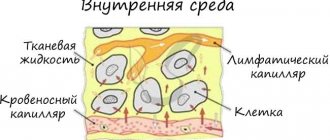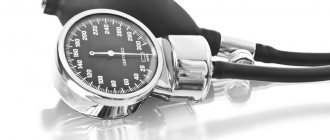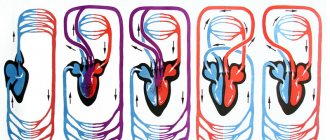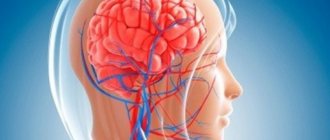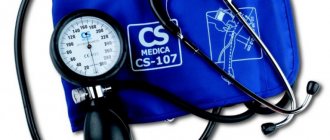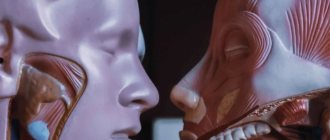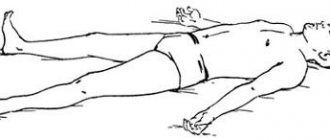What is blood pressure?
This is an indicator of the amount/force of blood pressure exerted on the walls of blood vessels. When measuring blood pressure with a tonometer, two numbers are taken into account - the lower and upper values. This is the value at the time of maximum tension of the heart muscle (systolic blood pressure or systole) and the value at the moment of its maximum relaxation (diastolic pressure or diastole).
Reference.
Blood pressure (BP) is not a constant value. Pressure readings may vary depending on a number of factors. Even in the same patient, blood pressure fluctuations are observed throughout the day. For example, in the morning after waking up, blood pressure may be low, but in the afternoon it may begin to rise.
Children have lower blood pressure than adults. The risk of developing arterial hypertension increases with age.
The table shows blood pressure standards (by age)
ARTERIAL PRESSURE
BLOOD PRESSURE, blood pressure in the arteries. Blood pressure level is expressed in millimeters of mercury (mm Hg) and depends on the pumping force of the heart, peripheral. vascular resistance and circulating blood volume. Systolic pressure reflects max. blood pressure on the walls of the arteries during contraction of the heart, diastolic - at the moment of its relaxation and depends mainly. from peripheral vascular resistance. In humans, for example, the systolic ratio and diastolic pressure is normally 120/80, in a giraffe 340/230, in a dog 156/100, in a shark 32/16 mm Hg. Art. There are also pulse pressure (the difference between systolic and diastolic), depending on the volume of blood ejected with each contraction of the heart and the elastic properties of the aorta, and average blood pressure (equal to the sum of diastolic and 1/3 pulse pressure), proportional to the volume of blood, ejected by the heart in 1 minute, and general peripheral. resistance of the blood vessel system. In most mammals (including humans) it is 100 mm Hg. Art. Blood pressure values decrease as the vessel moves away from the heart. For example, in a healthy adult, systolic. the pressure in the aorta is 110–130 mm Hg. Art., in arterioles – 20–50 mm Hg. Art. During the day it fluctuates depending on functional activity and decreases significantly at night during sleep (70–80 mm Hg). In vessels located above the level of the heart, the pressure decreases in proportion to the size of the hydrostatic column. A giraffe, for example, needs a high blood pressure so that blood can reach the head. Max. blood pressure values in annelids and arthropods are 5–10 mm Hg. Art., for active fish (e.g. salmon, eel) – 65–75, for the green frog – approx. 40, in birds – 140–180 mm Hg. Art. Male warm-blooded animals have a higher blood pressure than females, and cold-blooded animals have a lower blood pressure than warm-blooded animals.
In vertebrates, conservation refers. The constancy of the blood pressure level is ensured by a regulatory system, due to which a certain relationship is achieved between the work of the heart, the lumen of blood vessels, the capacity of the vascular bed and the amount of circulating blood. The action is physiological. regulation mechanisms can be short-term or long-term. The former include the renin-angiotensin-aldosterone system and cardiovascular reflexes. These reflexes are mediated through the center. nervous system (the so-called baroreflex, chemoreflex, cerebroischemic reaction), maintain a normal blood pressure level from several. minutes to several minutes hours.
Baroreceptors located in the wall of the aortic arch and in the area of the branch of the common carotid artery (carotid sinus) respond to the degree of stretching of the vascular wall with an increase in blood pressure. The frequency of impulses coming from the baroreceptors to the cardiovascular center in the medulla oblongata increases, which leads to to a reflex decrease in cardiac output and peripheral resistance. vessels and, as a consequence, a decrease in blood pressure. The higher the pressure in the aortic arch and carotid sinus, the stronger the nervous influences leading to a decrease in blood pressure. When blood pressure falls, the frequency of impulses coming from the baroreceptors decreases and reflexively increases cardiac output and resistance of small arteries and arterioles and hence pressure. The baroreflex acts as a buffer, smoothing out rapid fluctuations in blood pressure, for example. with a sharp transition from a horizontal to a vertical position, no phenomena associated with impaired blood supply to the brain are felt.
The chemoreflex is triggered both from the peripheral. receptors located in the aortic and carotid reflexogenic zones, and from the center. chemoreceptors localized in the medulla oblongata. The first ones are activated first. when there is a deficiency of oxygen in the blood, the latter react to an excess of carbon dioxide in it. Activation of chemoreceptors leads to reflex activation of the sympathoadrenal system. In the end, out of cuteness. nerve endings release norepinephrine, which acts on the so-called. alpha-1 adrenergic receptors on the smooth muscles of blood vessels and causes their constriction; beta-1 adrenergic receptors mediate an increase in cardiac output. Adrenaline secreted by the adrenal glands, through the activation of beta-2 adrenergic receptors, expands the bronchi, activates glycogenolysis, which leads to an increase in blood glucose.
The cerebroischemic reaction occurs when there is a significant decrease in the blood supply to the neurons of the cardiovascular center. When means. blood loss, the average blood pressure can drop to 60–70 mm Hg. Art., which leads to a deficiency of blood supply to the cardiovascular center and direct stimulation of the sympathoadrenal system and partial normalization of blood pressure. With blood loss accompanied by a decrease in blood pressure to 40–30 mm Hg. Art., hemorrhagic shock, as a rule, becomes irreversible.
When the renin-angiotensin system is activated, the increase in blood pressure is caused by the formation of angiotensin-II (formed with the participation of renin), which causes vasoconstriction, and an increase in the secretion of aldosterone, which leads to an increase in the volume of circulating blood.
Long-term regulation of blood pressure is carried out with the participation of the kidneys, which ensure a balance between the consumption and release of sodium and water ions; even a slight increase in blood pressure is accompanied by a significant increase in fluid secretion by the kidneys. It is well-functioning kidneys that maintain the average blood pressure within the normal range throughout a person’s life.
Blood pressure is most accurately measured directly using catheters inserted into blood vessels and connected to pressure sensors. A less accurate measurement method proposed by Ros. surgeon N. S. Korotkov in the beginning. 20th century, records the value of blood pressure using a tonometer - a pressure gauge connected to a rubber cuff, fastened around the arm in humans, and around a limb or tail (in rats) in animals. The air pumped into the cuff compresses the artery and the moment when the vessel stops passing blood is determined using a phonendoscope by the cessation of pulse sound vibrations. Slowly releasing air from the cuff, the moment of the sound caused by the contraction of the heart is recorded, and the systolic value is determined using the pressure gauge. pressure. The pressure gauge readings at the moment the pulse disappears correspond to the diastolic value. pressure.
In humans, blood pressure is considered elevated, at which the values of systolic. and diastolic pressures exceed 140 and 90 mm Hg, respectively. Art. A long-term increase in human blood pressure is arterial hypertension, a decrease is arterial hypotension.
What is the maximum blood pressure that can be withstood?
Any deviation of blood pressure from the norm can result in significant complications
It is important to know how much pressure a person can withstand. It is impossible to answer this question accurately
All people have certain characteristics of the body. They react differently to blood pressure deviations. Experts say that an increase of 25-30 units can already be regarded as a potential danger.
Hypertension can be diagnosed in a person whose blood pressure level exceeds 140/95. When blood pressure increases by 20 units, the patient experiences a whole range of unpleasant symptoms. The greatest danger is posed by a spontaneous and rapid increase in blood pressure, but small changes are usually short-lived.
Headache and high blood pressure are the main symptoms of hypertension
Experts note that it is rare to encounter patients whose upper blood pressure levels have reached 300 units. Not every person can withstand this level. Usually, at such rates, death occurs.
Experts say that the maximum blood pressure that a person can withstand is 260/140. At higher rates, many patients die or have irreversible consequences. This condition may lead to:
- heart failure;
- ischemic stroke;
- apoplexy.
To prevent irreversible consequences, you need to call a doctor as soon as possible when the first symptoms of increased blood pressure appear.
Blood pressure levels depend on many different factors. Experts recommend taking preventive measures to prevent its increase. To do this you need:
- take walks in the fresh air every day;
- give preference to moderate physical activity;
- completely change your diet and give preference to healthy foods;
- completely give up bad habits;
- avoid stressful situations;
- get as much rest as possible;
- get rid of excess weight;
- observe the drinking regime.
Follow simple rules to prevent hypertension
Nutrition has a significant impact on blood pressure and the cardiovascular system in general. Often, it is due to an incorrect diet that deviations occur. Experts recommend avoiding the use of:
- excessive amounts of salt (you can consume no more than 3 grams per day);
- instant food products;
- drinks with gas (it is better to give preference to homemade juices and fruit drinks);
- fatty meats and some dairy products;
- alcohol-containing drinks, since almost all alcohol leads to a rapid increase in blood pressure;
- seasonings, as they often contain excessive amounts of salt and harmful additives;
- mayonnaise - such a sauce causes an increase in cholesterol in the blood (this contributes to the formation of cholesterol plaques, which always lead to an increase in blood pressure).
It is also recommended to maintain a drinking regime. Every day you need to drink at least 2.5 liters of clean water.
Lack of water can cause high blood pressure
To treat hypertension, it is customary for a patient to be prescribed several medications, since combination therapy is most effective.
In some cases, treatment must be carried out continuously, especially if the patient has an advanced stage of arterial hypertension.
Most often, patients are prescribed the following medications:
All medications can only be prescribed by a doctor. The doctor selects the drug based on individual characteristics. Self-medication is prohibited, since a drug that has a positive effect on one patient may harm another patient. In some cases, side effects may occur after taking the medication. In this case, you will need to consult your doctor.
You can learn more about the causes of increased blood pressure and the appearance of hypertension from the video:
High pressure
High blood pressure due to hypertension must be treated immediately! Stage 2 hypertension (moderate) is characterized by its increase to a level from 160/100 to 180/110 mmHg. To bring its indicators back to normal at this stage of the disease, the use of medications is required. When examining patients diagnosed with stage 2 hypertension, an enlargement of the left ventricle of the heart is often detected.
Severe hypertension is diagnosed in cases with a persistent increase in blood pressure above 180/110 mmHg. Such high rates are usually accompanied by serious complications such as strokes, heart attacks, and renal dysfunction.
Symptoms of very high blood pressure and severe hypertension include:
- cardiac arrhythmia;
- nosebleeds;
- pain in the heart area;
- headache;
- disturbance of gait and coordination of movements;
- severe visual impairment;
- muscle weakness;
- paralysis (as a result of impaired cerebral circulation);
- coughing up blood;
- inability to self-service;
- speech disorder;
- clouding of consciousness.
To treat severe hypertension, potent drugs are prescribed or the doses of usual medications are increased. Patients with chronic pathology take pills for the rest of their lives.
